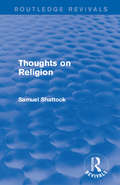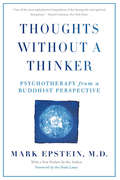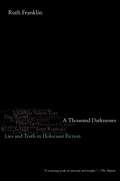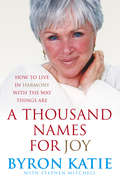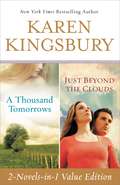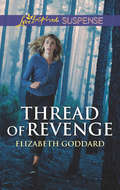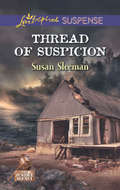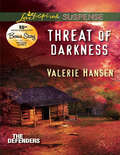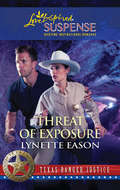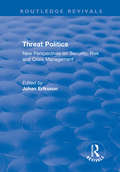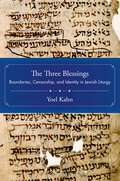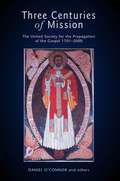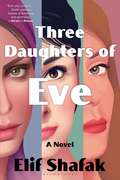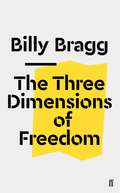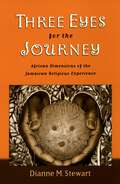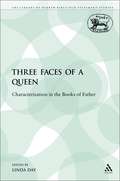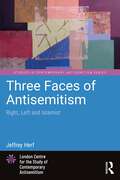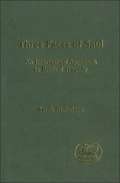- Table View
- List View
Thoughts on Religion (Routledge Revivals)
by Samuel ShattockThis book, first published in 1926, is a collection of the original thoughts of Samuel George Shattock on religious matters. Shattock recorded his thoughts on religion throughout his life. This title brings together what Shattock himself felt to be his most important ideas on theology. Thoughts on Religion will be of interest to students of religion and philosophy.
Thoughts on Religion (Routledge Revivals)
by Samuel ShattockThis book, first published in 1926, is a collection of the original thoughts of Samuel George Shattock on religious matters. Shattock recorded his thoughts on religion throughout his life. This title brings together what Shattock himself felt to be his most important ideas on theology. Thoughts on Religion will be of interest to students of religion and philosophy.
Thoughts Without A Thinker: Psychotherapy from a Buddhist Perspective
by Mark EpsteinBlending the lessons of psychotherapy with Buddhist teachings, Mark Epstein offers a revolutionary understanding of what constitutes a healthy emotional lifeThe line between psychology and spirituality has blurred, as clinicians, their patients, and religious seekers explore new perspectives on the self. A landmark contribution to the field of psychoanalysis, Thoughts Without a Thinker describes the unique psychological contributions offered by the teachings of Buddhism. Drawing upon his own experiences as a psychotherapist and meditator, New York-based psychiatrist Mark Epstein lays out the path to meditation-inspired healing, and offers a revolutionary new understanding of what constitutes a healthy emotional life.
A Thousand Darknesses: Lies and Truth in Holocaust Fiction
by Ruth FranklinWhat is the difference between writing a novel about the Holocaust and fabricating a memoir? Do narratives about the Holocaust have a special obligation to be 'truthful'--that is, faithful to the facts of history? Or is it okay to lie in such works? In her provocative study A Thousand Darknesses, Ruth Franklin investigates these questions as they arise in the most significant works of Holocaust fiction, from Tadeusz Borowski's Auschwitz stories to Jonathan Safran Foer's postmodernist family history. Franklin argues that the memory-obsessed culture of the last few decades has led us to mistakenly focus on testimony as the only valid form of Holocaust writing. As even the most canonical texts have come under scrutiny for their fidelity to the facts, we have lost sight of the essential role that imagination plays in the creation of any literary work, including the memoir. Taking a fresh look at memoirs by Elie Wiesel and Primo Levi, and examining novels by writers such as Piotr Rawicz, Jerzy Kosinski, W.G. Sebald, and Wolfgang Koeppen, Franklin makes a persuasive case for literature as an equally vital vehicle for understanding the Holocaust (and for memoir as an equally ambiguous form). The result is a study of immense depth and range that offers a lucid view of an often cloudy field.
A Thousand Darknesses: Lies and Truth in Holocaust Fiction
by Ruth FranklinWhat is the difference between writing a novel about the Holocaust and fabricating a memoir? Do narratives about the Holocaust have a special obligation to be 'truthful'--that is, faithful to the facts of history? Or is it okay to lie in such works? In her provocative study A Thousand Darknesses, Ruth Franklin investigates these questions as they arise in the most significant works of Holocaust fiction, from Tadeusz Borowski's Auschwitz stories to Jonathan Safran Foer's postmodernist family history. Franklin argues that the memory-obsessed culture of the last few decades has led us to mistakenly focus on testimony as the only valid form of Holocaust writing. As even the most canonical texts have come under scrutiny for their fidelity to the facts, we have lost sight of the essential role that imagination plays in the creation of any literary work, including the memoir. Taking a fresh look at memoirs by Elie Wiesel and Primo Levi, and examining novels by writers such as Piotr Rawicz, Jerzy Kosinski, W.G. Sebald, and Wolfgang Koeppen, Franklin makes a persuasive case for literature as an equally vital vehicle for understanding the Holocaust (and for memoir as an equally ambiguous form). The result is a study of immense depth and range that offers a lucid view of an often cloudy field.
A Thousand Names For Joy: How To Live In Harmony With The Way Things Are
by Byron Katie Stephen MitchellInspired by the Tao Te Ching, this is Byron Katie's inspiring and pragmatic approach to achieving an awakened mind and living more simply and profoundly. Using the template of the 81 chapters of the Tao Te Ching she talks about her own experience of living in harmony with the way things are, and the difference between what hurts and what doesn't. Katie has written two books that teach how suffering can be relieved by questioning the thoughts that create it, the thoughts that argue with reality. This questioning takes courage and, in this her third book, she gives readers profound encouragement by showing them the freedom and love that live on the other side of self-inquiry.Many people believe that although enlightenment was attainable thousands of years ago by a few great saints or ascetics, such a state is out of reach of anyone living in the modern world, let alone themselves. This richly detailed account has the ability to change that belief.Katie's comments on life, and how to live it, are profound, vibrant, funny and crystal clear and all rooted in the familiar circumstances of everyday life.
A Thousand Tomorrows & Just Beyond The Clouds Omnibus
by Karen KingsburyBestselling author Karen Kingsbury weaves a powerful story of a young couple whose love must face the ultimate challenge.
Thread Of Revenge: Thread Of Revenge Plain Jeopardy Mountain Refuge (Coldwater Bay Intrigue #1)
by Elizabeth GoddardCOAST GUARD PROTECTOR
Thread of Suspicion: Danger In Amish Country; Thread Of Suspicion; The Reluctant Witness; Warning Signs (The Justice Agency #4)
by Susan SleemanWhen someone sabotages ex-Navy SEAL Luke Baldwin’s “unhackable” software, there’s more than his reputation at stake. Faced with treason charges, Luke turns to Dani Justice, a computer expert and skilled investigator. She’s eager to dive into the challenging case…
Threat Of Darkness (The Defenders #2)
by Valerie Hansen Arlene JamesRiveting romantic suspense to set your heart racing! Heroic and courageous characters battle against danger and face challenges to their faith… and to their lives. TO PROTECT THE CHILD
Threat of Exposure (Texas Ranger Justice #5)
by Lynette EasonPages full of indecipherable codes are all that stand between DEA agent Brock Martin and drugs crossing the border. But if he wants to crack the case, he'll have to work with Texas Ranger Gisella Hernandez.
Threat Politics: New Perspectives on Security, Risk and Crisis Management (Routledge Revivals)
by Johan ErikssonThis title was first published in 2001. Aiming to open up a new perspective on the study of threats and risks, this text combines insights from the thematically linked but academically disassociated fields of security studies, risk studies and crisis management studies. It provides case studies of key agents, arenas and issues involved in the politics of threats. In addition to the traditional unit of analysis - national governments - this book takes into account non-governmental agents, including public opinion, the media and business.
Threat Politics: New Perspectives on Security, Risk and Crisis Management (Routledge Revivals)
by Johan ErikssonThis title was first published in 2001. Aiming to open up a new perspective on the study of threats and risks, this text combines insights from the thematically linked but academically disassociated fields of security studies, risk studies and crisis management studies. It provides case studies of key agents, arenas and issues involved in the politics of threats. In addition to the traditional unit of analysis - national governments - this book takes into account non-governmental agents, including public opinion, the media and business.
The Three Blessings: Boundaries, Censorship, and Identity in Jewish Liturgy
by Yoel KahnIn the traditional Jewish liturgy, a man thanks God daily for not having been made a gentile, a woman, or a slave. Yoel Kahn traces the history of this prayer from its extra-Jewish origins to the present, demonstrating how different generations and communities understood the significance of these words. Marginalized and persecuted groups used this prayer to mark the boundary between "us" and "them," affirming their own identity and sense of purpose. After the medieval Church seized and burned books it considered offensive, new, coded formulations of the three blessings emerged as forms of spiritual resistance. Book owners voluntarily expurgated the passage to save the books from being destroyed, creating new language and meaning while seeking to preserve the structure and message of the received tradition. During the Renaissance, Jewish women defied their rabbis and declared their gratitude at being "made a woman and not a man." And, as Jewish emancipation began in the nineteenth century, Jews again had to balance fealty to historical practice with their place in the world. Seeking to be recognized as modern and European, early modern Jews rewrote the liturgy to suit modern sensibilities and identified themselves with the Christian West against the historical pagan and the uncivilized infidel. The Three Blessings is an insightful and wide-ranging study of one of the most controversial Jewish prayers, showing its constantly evolving language, usage, and interpretation over the past 2,000 years.
Three Centuries of Mission: The United Society for the Propagation of the Gospel 1701-2000
by Daniel O'ConnorA new and expansive official history of the USPG commissioned to mark the tercentenary in 2001. The first half tells a compelling global story from the mission to the Americas in the 18th century, through the North China Mission in the late 19th century to today's Social Development Programme in Bangladesh. There is a particular focus on the post-1945 period of decolonization, development and dialogue with other religions. The second half is a collection of essays that give a wide range of themes and perspective from a history of missionary wives by Deborah Kirkwood to a discussion of the evolving role of the church in Zambia by Musonda Mwamba.Three Centuries of Mission emphasizes the key instrumentality of the USPG in the emergence of a worldwide network of Churches in the Anglican Communion and their significance in the world at the beginning of the new century.
Three crosses on a hill (Large print)
by RnibThis is an image of the three crosses on Calvary Hill in readiness for the crucifixion of Jesus Christ and the two thieves. There is a locator dot shown, which will be at the top left of the page when the image is the correct way up. The image is surrounded by a dashed line image border. The crosses are shown in silhouette at dusk in the centre of the page. The sky is blue and pink with the sun in the left centre of the page and white and pink clouds stretching across the page. The hill is in purple shadow at the bottom of the page.
Three crosses on a hill (UEB Contracted)
by RnibThis is an image of the three crosses on Calvary Hill in readiness for the crucifixion of Jesus Christ and the two thieves. There is a locator dot shown, which will be at the top left of the page when the image is the correct way up. The image is surrounded by a dashed line image border. The crosses are shown in silhouette at dusk in the centre of the page. The sky is blue and pink with the sun in the left centre of the page and white and pink clouds stretching across the page. The hill is in purple shadow at the bottom of the page.
Three crosses on a hill (UEB Uncontracted)
by RnibThis is an image of the three crosses on Calvary Hill in readiness for the crucifixion of Jesus Christ and the two thieves. There is a locator dot shown, which will be at the top left of the page when the image is the correct way up. The image is surrounded by a dashed line image border. The crosses are shown in silhouette at dusk in the centre of the page. The sky is blue and pink with the sun in the left centre of the page and white and pink clouds stretching across the page. The hill is in purple shadow at the bottom of the page.
Three Daughters of Eve
by Elif ShafakAn Indie Next PickThe stunning, timely new novel from the acclaimed, internationally bestselling author of The Architect's Apprentice and The Bastard of Istanbul.Peri, a married, wealthy, beautiful Turkish woman, is on her way to a dinner party at a seaside mansion in Istanbul when a beggar snatches her handbag. As she wrestles to get it back, a photograph falls to the ground--an old polaroid of three young women and their university professor. A relic from a past--and a love--Peri had tried desperately to forget.Three Daughters of Eve is set over an evening in contemporary Istanbul, as Peri arrives at the party and navigates the tensions that simmer in this crossroads country between East and West, religious and secular, rich and poor. Over the course of the dinner, and amidst an opulence that is surely ill-begotten, terrorist attacks occur across the city. Competing in Peri's mind however are the memories invoked by her almost-lost polaroid, of the time years earlier when she was sent abroad for the first time, to attend Oxford University. As a young woman there, she had become friends with the charming, adventurous Shirin, a fully assimilated Iranian girl, and Mona, a devout Egyptian-American. Their arguments about Islam and feminism find focus in the charismatic but controversial Professor Azur, who teaches divinity, but in unorthodox ways. As the terrorist attacks come ever closer, Peri is moved to recall the scandal that tore them all apart. Elif Shafak is the number one bestselling novelist in her native Turkey, and her work is translated and celebrated around the world. In Three Daughters of Eve, she has given us a rich and moving story that humanizes and personalizes one of the most profound sea changes of the modern world.
The Three Dimensions of Freedom (Faber Social Ser.)
by Billy BraggAt a time when opinion trumps facts and truth is treated as nothing more than another perspective, free speech has become a battleground. While authoritarians and algorithms threaten democracy, we argue over who has the right to speak.To protect ourselves from encroaching tyranny, we must look beyond this one-dimensional notion of what it means to be free and, by reconnecting liberty to equality and accountability, restore the individual agency engendered by the three dimensions of freedom.
Three Eyes for the Journey: African Dimensions of the Jamaican Religious Experience
by Dianne M. StewartStudies of African-derived religious traditions have generally focused on their retention of African elements. This emphasis, says Dianne Stewart, slights the ways in which communities in the African diaspora have created and formed new religious meaning. In this fieldwork-based study Stewart shows that African people have been agents of their own religious, ritual, and theological formation. She examines the African-derived and African-centered traditions in historical and contemporary Jamaica: Myal, Obeah, Native Baptist, Revival/Zion, Kumina, and Rastafari, and draws on them to forge a new womanist liberation theology for the Caribbean.
Three Faces of a Queen: Characterization in the Books of Esther (The Library of Hebrew Bible/Old Testament Studies)
by Linda DayThis original study offers, for the first time, an analysis of the characterization of Esther as she is portrayed in each of the three primary versions of the book of Esther-the Masoretic text, the Septuagint text, and the Greek a text. This study of characterization has implications beyond itself. It permits a reasssessment of relations between the book of Esther and other literature of the time, it sheds light on the place of origin of the ancient versions of Esther, and it raises serious feminist and canon-critical questions about the role of the book.
Three Faces of Antisemitism: Right, Left and Islamist (Studies in Contemporary Antisemitism)
by Jeffrey HerfThree Faces of Antisemitism examines the three primary forms of antisemitism as they emerged in modern and contemporary Germany, and then in other countries.The chapters draw on the author’s historical scholarship over the years on the form antisemitism assumed on the far right in Weimar and Nazi Germany, in the Communist regime in East Germany, and in the West German radical left, and in Islamist organizations during World War II and the Holocaust, and afterward in the Middle East. The resurgence of antisemitism since the attacks of September 11, 2001, has origins in the ideas, events, and circumstances in Europe and the Middle East in the half century from the 1920s to the 1970s. This book covers the period since 1945 when neo-Nazism was on the fringes of Western and world politics, and the persistence of antisemitism took place primarily when its leftist and Islamist forms combined antisemitism with anti-Zionism in attacks on the state of Israel. The collection includes recent essays of commentary that draw attention to the simultaneous presence of antisemitism’s three faces. While scholarship on the antisemitism of the Nazi regime and the Holocaust remains crucial, the scholarly, intellectual, and political effort to fight antisemitism in our times requires the examination of antisemitism’s leftist and Islamist forms as well.This book will be of interest to scholars researching antisemitism, racism, conspiracy theories, the far right, the far left, and Islamism.
Three Faces of Antisemitism: Right, Left and Islamist (Studies in Contemporary Antisemitism)
by Jeffrey HerfThree Faces of Antisemitism examines the three primary forms of antisemitism as they emerged in modern and contemporary Germany, and then in other countries.The chapters draw on the author’s historical scholarship over the years on the form antisemitism assumed on the far right in Weimar and Nazi Germany, in the Communist regime in East Germany, and in the West German radical left, and in Islamist organizations during World War II and the Holocaust, and afterward in the Middle East. The resurgence of antisemitism since the attacks of September 11, 2001, has origins in the ideas, events, and circumstances in Europe and the Middle East in the half century from the 1920s to the 1970s. This book covers the period since 1945 when neo-Nazism was on the fringes of Western and world politics, and the persistence of antisemitism took place primarily when its leftist and Islamist forms combined antisemitism with anti-Zionism in attacks on the state of Israel. The collection includes recent essays of commentary that draw attention to the simultaneous presence of antisemitism’s three faces. While scholarship on the antisemitism of the Nazi regime and the Holocaust remains crucial, the scholarly, intellectual, and political effort to fight antisemitism in our times requires the examination of antisemitism’s leftist and Islamist forms as well.This book will be of interest to scholars researching antisemitism, racism, conspiracy theories, the far right, the far left, and Islamism.
Three Faces of Saul: An Intertextual Approach to Biblical Tragedy (The Library of Hebrew Bible/Old Testament Studies)
by Sarah NicholsonA fascinating intertextual study of the classic biblical tragedy of Saul, the first king of Israel, as first narrated in biblical narrative and later reworked in Lamartine's drama Saul: Tragédie and Thomas Hardy's novel The Mayor of Casterbridge. Plot and characterization are each explored in detail in this study, and in each of the narrations the hero's tragic fate emerges both as the result of a character flaw and also as a consequence of the ambivalent role of the deity, showing a double theme underlying not only the biblical vision but also its two very different retellings nearer to our own times.
